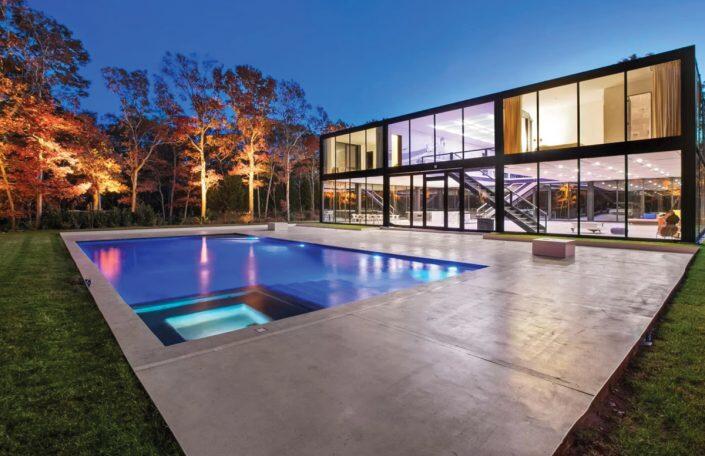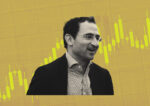Trending
Brokers react to reality TV’s “Selling the Hamptons”
Nest Seekers’ reality show has been renewed for a second season, but some local agents aren’t sold

A hot pink suit is a bold choice, but boy, does it look good on camera. So do shiny blowouts, stilettos and metallic gold evening gowns. Against the backdrop of beautiful East Hampton, five equally beautiful people almost seem to glow as they smile, pose, check their phones, preen and pose some more.
The sky is blue, the booze is flowing and everyone seems to be having a good time — until a stone-faced, important-looking suit arrives, erasing all the smiles without saying a word.
It’s a big night, and he’s disappointed. Where are the decorations? Where is the music? Why is nobody greeting the guests at the door?
The people didn’t come here to take pictures and pregame. It’s an open house, and they’re here to sell a $7 million, 10,000-square-foot glass cube to the richest person they can find.
The frantic energy of an upscale work function meets the shameless self-indulgence of youth on the first episode of “Selling the Hamptons,” a reality series on the streaming service Discovery+ that follows five Nest Seekers agents as they deal with professional mermaids, manic FaceTime showings and lofty promises of as many bidets as their client’s heart desires.
On a steady diet of espresso martinis and who knows what else, the nonstop hustlers show the clients, the audience and each other that, except for properly organizing a showing, they can do whatever it takes to close the deal.
The show, which premiered this year, garnered enough eyeballs to be renewed for a second season — and nearly as many eye rolls from brokers who have been “selling the Hamptons” since long before it (and some of the agents it follows) was conceived.
Dramatis personae
In the first episode, viewers meet Nest Seekers agent JB Andreassi and five colleagues he claims to know the Hamptons “100 times better than.” In a cerulean seersucker that matches his eyes, Andreassi presents his credentials: grainy photos of himself as a kid riding a tractor with his dad — according to JB’s website, “one of the founding fathers of Hamptons luxury real estate.”
As fellow agent Mia Calabrese put it: “You can always spot a Dartmouth man. They always look like JB.”
Calabrese has “big dick energy” and isn’t afraid to say it. She boasts experience in upscale event planning, catering to Saudi princes and tech billionaires. Over at Duck Pond Lane in Southampton, we meet Peggy Zabakolas, a Manhattan-based agent with a whatever-it-takes attitude to selling. Zabakolas had a humble upbringing in an immigrant family, to whom $100,000 was “mind-blowing,” she says just before a jump cut to her Christian Louboutin shoes.
Then we have Andreassi’s Dartmouth buddy and best friend, the baby-faced Michael Fulfree, a hands-on agent with a sunny disposition and a bright yellow blazer to match. In the second episode, we meet Kenny Arias, who tempers the fast pace of his castmates with relaxed energy. They drink espresso martinis, he orders caramel cold brew. They talk a mile a minute, he takes his time.
The agents find a common enemy in Bianca D’Alessio, the brokerage’s head of new development sales. Bianca is deputized by the aforementioned important-looking suit, Nest Seekers CEO Eddie Shapiro, to keep things running up to standard.
In a later episode, the gang meets up for drinks. When Bianca is late, the agents take the opportunity to engage in everybody’s favorite time-honored tradition: bitching about middle management.
Andreassi finds Arias’ impromptu cannonballs during showings unacceptable — which, to buyers and sellers of ultra-high-end Hamptons real estate, they may well be. But while petty conflicts are the tried and true basis of all reality shows, particularly those about real estate agents, the ones on “Selling the Hamptons” feel particularly juvenile.
Other egregious faux pas on the show include inviting someone else’s contact to a party without giving them a heads-up, having landscapers working on a property during a showing and being featured on the cover of a magazine (They picked her? Why not me?).
But these agents aren’t just sitting around making mountains out of molehills — they’re also building sandcastles in the sky.
In the series’ first episode, Shawn Elliott, president of Nest Seekers’ Ultra Luxury Division, assures a client, homebuilder Yale Fishman, that his $35 million listing on Duck Pond Lane in Southampton can totally be ready to hit the market within 10 days. In another episode, Fulfree promises a client that seven bidets can be installed in a home within 36 hours — no problem. When prospective buyers hit Arias up regarding a listing that wasn’t technically his, of course he had to do the showing because, well, they were just so excited. Anything for the client, right?

145 Neck Path, East Hampton
The listing in question belonged to Andreassi, who knows that it’s better to face these kinds of things with a sense of poise and rationality. When Arias mentioned the showing over drinks with the rest of the gang, Andreassi smiled and kept his mouth shut.
Later, he sat Arias down, bought him a beer and instructed him to never show one of his listings — or jump into a client’s pool — again.
Andreassi reprimanding Arias for “accidentally” going behind his back may have been dramatized, but the episode mirrored some of the firm’s off-screen controversies.
A fresh start
Nest Seekers has been accused by competitors in both the Hamptons and South Florida of falsely claiming involvement or exclusivity on listings, though it has repeatedly denied wrongdoing.
The very genesis of “Selling the Hamptons” seems to be open to interpretation — or obfuscation. The series is in many ways a spiritual successor to “Million Dollar Beach House,” a six-episode series starring Andreassi, Fulfree and Zabakolas, among other Nest Seekers agents, that debuted on Netflix in 2020 to mixed-at-best reviews.
New York magazine described it as “the bleakest show on TV.” Variety called it “flat.” Glamour reported what viewers perceived as “racist vibes” and “microaggressions” against Black cast member Noel Roberts.
The series did not return for a second season. Reached for comment by TRD in November, Shapiro denied that it had been canceled, but deferred further comment to its production company, Diga Studios, which did not respond to inquiries.
Fulfree told TRD that “Selling the Hamptons” would be a fresh start.
“It is a completely different show than the first one, how it’s formatted,” he said last year. “We were all in the infancy of our careers, the first year being in real estate. Now it’s more serious, we take things differently.”
The market, too, had changed since 2019, Fulfree pointed out. He and his co-stars no longer “had to beg for a listing and hope a deal would get done.”
Reality TV meets reality
Maybe it’s the pressure of a hot market — or the manufactured urgency of reality television — but the fast-paced, cutthroat, “sell or die” mentality depicted on “Selling the Hamptons” could not be further from the experience that Corcoran’s Gary DePersia, a longtime Hamptons broker, describes when talking about his early career in the area.
When DePersia broke into East End real estate in 1995, he didn’t sell a single house in his first year on the job. “Don’t worry,” a mentor told him. “You’ll sell some houses.”
That’s a far cry from the message another developer on the series had for agents at an opening for a $21 million Southampton home: “If you can’t sell this house, you will all be replaced.”
Mala Sander, another Corcoran agent with over 20 years of experience, said the experienced brokers she worked with earlier in her career emphasized integrity over hustle, something to which she attributes much of her success.
The rise of social media, reality TV and personal branding in residential brokerage can tempt the fake-it-till-you-make-it approach, one that Sander doesn’t believe in.
“You can fog a mirror and get your real estate license,” she said. “But you gotta know what you’re doing.”
There is evidence that the agents on the show know what they’re doing. Andreassi’s page on Nest Seekers’ website says he’s sold 25 properties for between $1 million and $25 million since the start of 2020. Zabakolas has been in the industry for a decade since graduating from law school in 2012.
Sander has just 4,300 Instagram followers and no IMDB page, but she says her clients trust her to give it to them straight and deliver on her promises. And she trusts them to see through the forced urgency and what she called the “horribly overpriced” listings portrayed on the show.
For this reason, Sander and DePersia both emphasized the importance of proper mentoring — not from the people paying you to make a sale, but from other brokers who have been in your shoes.
“Align yourself with an experienced broker when you start,” says DePersia. “Otherwise, you may be floundering a little bit.”
Sander said there was more to a deal than just the dollar amount.
“I did $10,000 rentals just to have the experience of working with a client,” she said.
DePersia feels similarly. “Brokers should not be afraid to do rentals,” he says. “Renters become buyers, landlords become sellers, and you get referrals from both,” something that Fulfree pointed out to a client on “Selling the Hamptons” when a rental offer was the best he could do.
For both brokers, relationships and networking are at the center of a successful, long-term career in real estate.
Robust social media presences and lavish parties are great, but it doesn’t matter how many expensive sports cars are showcased outside an open house if nobody’s taking names at the door.




